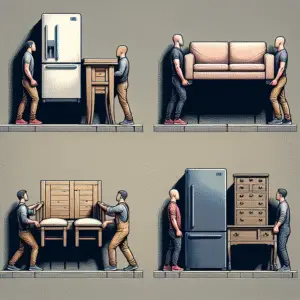DIY Moving Truck Loading Guide
DIY Moving Truck Loading Guide: Master the Art of Efficient Packing
Why Proper Truck Loading Can Make or Break Your Move
Loading a moving truck isn’t just about fitting everything in—it’s about protecting your belongings, maximizing space, and ensuring a safe journey. Poor loading techniques can lead to damaged items, wasted space, and even dangerous driving conditions. Master these proven strategies to load like a professional mover.
Pre-Loading Preparation Checklist
- Gather all packing supplies (straps, dollies, blankets, bubble wrap)
- Create an inventory list with room-by-room organization
- Disassemble large furniture and keep hardware in labeled bags
- Pack a “first load” box with essentials for your new home
- Recruit 2-4 helpers and assign specific roles
- Take photos of valuable items for insurance purposes
1
Foundation Layer: Heavy Items & Appliances (First 30 minutes)
Start with the Heaviest Items
Begin loading from the front of the truck, placing your heaviest items against the cab wall. This creates a stable foundation and prevents items from shifting during transport. Refrigerators, washers, dryers, and safes should go in first.
Weight Distribution Strategy
Keep the truck’s center of gravity low and balanced. Place heavy items on the floor, distributed evenly from left to right. Never stack heavy items high—this makes the truck top-heavy and dangerous to drive.
Securing the Foundation
Use ratchet straps to secure heavy appliances to the truck’s tie-down points. Wrap fragile surfaces with moving blankets and use furniture pads to prevent scratching. Leave no gaps where items can shift.
Use a dolly or hand truck for all heavy items. Your back will thank you, and you’ll move faster. Always lift with your legs, not your back, and ask for help with anything over 50 pounds.
2
Furniture Layer: Creating Walls and Structure (Next 45 minutes)
Building Furniture Walls
Place tall furniture pieces like dressers, bookcases, and wardrobes upright against the truck walls. These create natural “walls” that help organize your load and provide additional tie-down points for securing other items.
Mattress and Box Spring Placement
Stand mattresses and box springs on their sides along the truck walls. Use mattress bags for protection and place them between other furniture pieces to save space. Never lay mattresses flat unless it’s your final layer.
Filling Furniture Gaps
Use drawers, shelves, and cabinets as natural storage containers. Fill dresser drawers with clothes, linens, or books. This maximizes space and reduces the number of separate boxes you need to pack.
3
Box Tetris: Strategic Box Loading (Next 30 minutes)
Heavy Boxes on Bottom
Stack boxes like a pyramid with heaviest on the bottom. Books, dishes, and tools should be in bottom layers. Keep box weight under 50 pounds and ensure all boxes are properly sealed and labeled.
Creating Stable Columns
Stack boxes in straight columns rather than staggered patterns. This creates more stability and makes it easier to load and unload. Use different sized boxes to fill gaps and create a tight, secure load.
Fragile Item Protection
Place fragile boxes between mattresses or furniture pieces for extra protection. Never put fragile items on the bottom of stacks, and always mark “FRAGILE” clearly on multiple sides of the box.
Essential Loading Principles
Weight Distribution Rule
Keep 60% of weight in the front half of the truck to maintain proper vehicle balance. This prevents swaying and makes driving safer, especially on highways and during turns.
Tie-Down Strategy
Use a minimum of 4 tie-down points for every major section of your load. Ratchet straps should be snug but not over-tightened, which can damage items or cause straps to snap during transport.
Space Maximization
Fill every cubic inch by nesting smaller items inside larger ones. Use soft items like pillows and blankets to fill gaps and provide additional cushioning for fragile items.
Loading Mistakes That Cost Time and Money
- Loading Without a Plan: Random loading wastes 30-40% more space and increases damage risk. Always visualize your load before you start.
- Ignoring Weight Limits: Overloading your truck is illegal and dangerous. Check your rental agreement for weight restrictions and stick to them.
- Poor Box Labeling: Unlabeled boxes become a nightmare during unloading. Mark contents and destination room on at least two sides of every box.
- Leaving Empty Spaces: Gaps allow items to shift and break. Fill every space with padding, small items, or soft goods.
- Forgetting Tools and Supplies: Keep a toolbox accessible for last-minute disassembly and have extra straps, blankets, and tape on hand.
Final Loading Day Checklist
- Double-check all tie-downs and straps before closing the truck
- Take photos of your loaded truck for insurance documentation
- Keep a small “survival kit” in the cab (water, snacks, phone charger)
- Review your route and identify rest stops for checking your load
- Ensure you have contact info for helpers at your destination
- Keep important documents and valuable items with you, not in the truck
Master Your Move with Professional Loading Techniques
Proper truck loading isn’t just about fitting everything in—it’s about protecting your memories, saving money on damages, and reducing stress during one of life’s biggest transitions.
With these proven strategies, you’ll load like a professional, maximize your space, and ensure everything arrives safely at your new home.
Take your time, follow the plan, and remember—a well-loaded truck is the foundation of a successful move!







